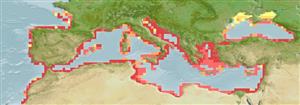Masukkan pemerhatian anda di Fish Watcher
| Native range | All suitable habitat | Point map | Year 2050 |

|
| This map was computer-generated and has not yet been reviewed. |
| Chelon saliens AquaMaps Data sources: GBIF OBIS |
muatnaik fotos/gambar dan video
Pictures | imej GoogleChelon saliens
Picture by Abbasi, K.
Pictures | imej GoogleChelon saliens
Picture by Abbasi, K.
Bulgaria country information
Common names:
Ilaria
Occurrence: native
Salinity: freshwater
Abundance: | Ref:
Importance: | Ref:
Aquaculture: | Ref:
Regulations: | Ref:
Uses: no uses
Comments:
National Checklist:
Country Information: https://www.cia.gov/library/publications/resources/the-world-factbook/geos/bu.html
National Fisheries Authority:
Occurrences: Occurrences Point map
Main Ref: Hureau, J.-C. and T. Monod (eds.), 1979
National Database:
Occurrence: native
Salinity: freshwater
Abundance: | Ref:
Importance: | Ref:
Aquaculture: | Ref:
Regulations: | Ref:
Uses: no uses
Comments:
National Checklist:
Country Information: https://www.cia.gov/library/publications/resources/the-world-factbook/geos/bu.html
National Fisheries Authority:
Occurrences: Occurrences Point map
Main Ref: Hureau, J.-C. and T. Monod (eds.), 1979
National Database:
Common names from other countries
klasifikasi / Names Nama-nama umum | Sinonim (persamaan) | Catalog of Fishes(Marga, Jenis) | ITIS | CoL | WoRMS | Cloffa
> Mugiliformes (Mullets) > Mugilidae (Mullets)
Etymology: Chelon: Greek, chelone = turtle (Ref. 45335).
More on author: Risso.
Etymology: Chelon: Greek, chelone = turtle (Ref. 45335).
More on author: Risso.
Environment: milieu / climate zone / depth range / distribution range Ekologi
laut; payau dasar (demersal); kisaran kedalaman 10 - ? m (Ref. 3573). Subtropical; 47°N - 29°N, 11°W - 42°E
Penyebaran Negara-negara | Daerah-daerah FAO | Ecosystems | Kemunculan | Point map | Introduksi | Faunafri
Eastern Atlantic: Mediterranean Sea, the Black Sea, Sea of Azov and Atlantic coasts from Morocco to France. Introduced to Iran and is now naturally occurring in the Caspian Sea basin (Ref. 50218).
Length at first maturity / Size / Weight / umur
Maturity: Lm 21.3, range 17 - 22 cm
Max length : 40.0 cm SL jantan/; (Ref. 3397); common length : 30.0 cm TL jantan/; (Ref. 9987)
Max length : 40.0 cm SL jantan/; (Ref. 3397); common length : 30.0 cm TL jantan/; (Ref. 9987)
Adults usually in schools inhabit coastal waters (Ref. 3573); sometimes in lagoons and estuaries (Ref. 59043). Juveniles around 2.0 cm SL move to coastal lagoons and estuaries in summer and autumn (Ref. 59043). Adults are herbivorous feeding on algae and vegetal detritus while juveniles feed on zooplankton until about 3 cm SL, then on benthic organisms until 5 cm SL (Ref. 9987, 59043). Reproduce in summer (Ref. 2804). Oviparous, eggs are pelagic and non-adhesive (Ref. 205). Utilized for roe, but also fresh, smoked and frozen (Ref. 9987).
Life cycle and mating behavior Kematangan | Reproduksi, perkembang biakan | Pemijahan | telur-telur | Fecundity | Larva
rujukan utama
Upload your references | Acuan | Koordinator : Harrison, Ian | mitra
Thomson, J.M., 1986. Mugilidae. p. 344-349. In J. Daget, J.-P. Gosse and D.F.E. Thys van den Audenaerde (eds.) Check-list of the freshwater fishes of Africa (CLOFFA). ISNB, Brussels, MRAC; Tervuren; and ORSTOM, Paris. Vol. 2. (Ref. 3573)
Status IUCN Red List (Ref. 130435: Version 2024-1)
kurang bimbang (LC) ; Date assessed: 01 January 2008
ancaman kepada manusia
Harmless
penggunaan manusia
Perikanan: nilai komersial kecil; Budidaya air: komersial
FAO(Perikanan: production; publication : search) | FishSource | Sea Around Us
informasi lanjut
Population dynamics
Growth parameters
Max. ages / sizes
Length-weight rel.
Length-length rel.
ukuran frekuensi
Mass conversion
pemulihan
Kelimpahan
Growth parameters
Max. ages / sizes
Length-weight rel.
Length-length rel.
ukuran frekuensi
Mass conversion
pemulihan
Kelimpahan
Life cycle
Reproduksi, perkembang biakan
Kematangan
Fecundity
Pemijahan
Spawning aggregations
telur-telur
pekembangan telor
Larva
Dinamika larva
Reproduksi, perkembang biakan
Kematangan
Fecundity
Pemijahan
Spawning aggregations
telur-telur
pekembangan telor
Larva
Dinamika larva
Anatomy
Area insang
Brain
Otolith
Area insang
Brain
Otolith
Physiology
Body composition
Nutrients
Oxygen consumption
Swimming type
Swimming speed
Visual pigments
Fish sound
Diseases & Parasites
Toxicity (LC50s)
Body composition
Nutrients
Oxygen consumption
Swimming type
Swimming speed
Visual pigments
Fish sound
Diseases & Parasites
Toxicity (LC50s)
Human related
Aquaculture systems
profil budidaya air
Strain
Ciguatera cases
Stamps, coins, misc.
Aquaculture systems
profil budidaya air
Strain
Ciguatera cases
Stamps, coins, misc.
Alat, peralatan
E-book | Penuntun lapangan | Kunci identifiaksi (pengenalan) | tanda freqkuenci panjang | peringkat sejarah hidup | peta titik | Classification Tree
| Catch-MSY |
laporan khas
muat turun XML
Sumber internet
Alien/Invasive Species database | Aquatic Commons | BHL | Cloffa | Websites from users | semak peneliti ikan | CISTI | Catalog of Fishes(Marga, Jenis) | DiscoverLife | ECOTOX | Faunafri | Fishtrace | GenBank(genom, Nukleotida) | GloBI | GOBASE | | Google Books | Google Scholar | Google | IGFA World Record | MitoFish | Pangkalan data nasional | Otolith Atlas of Taiwan Fishes | Akuarium publik | PubMed | Reef Life Survey | Scirus | SeaLifeBase | Tree of Life | Wikipedia(pergi, Cari) | World Records Freshwater Fishing | Zoological Record
Estimates based on models
Preferred temperature (Ref. 115969): 14.4 - 21.5, mean 18.4 (based on 154 cells).
Phylogenetic diversity index (Ref. 82804): PD50 = 0.5005 [Uniqueness, from 0.5 = low to 2.0 = high].
Bayesian length-weight: a=0.01072 (0.00898 - 0.01278), b=2.96 (2.93 - 2.99), in cm Total Length, based on LWR estimates for this species (Ref. 93245).
Trophic level (Ref. 69278): 2.9 ±0.38 se; based on food items.
Daya lenting (Ref. 120179): sedang, Waktu penggandaan populasi minimum 1.4 - 4.4 tahun (K=0.2-0.3; tm=3-4).
Fishing Vulnerability (Ref. 59153): Moderate to high vulnerability (45 of 100).
Climate Vulnerability (Ref. 125649): Moderate vulnerability (39 of 100).




